There something funny that happens to Barcelona when they face an opponent wearing white at the Camp Nou that just flips the switch and the Catalan machine becomes unhinged. First, it happened to Real Madrid in La Liga, and now Sevilla have felt the same wrath.
All levity aside, it really was an entertaining night as Barcelona left nothing to chance and instead crushed their guests to secure a spot in the semi-finals of the Copa del Rey. Their hunt for a fifth consecutive title continues as yet another “remuntada” (comeback) made sure the Blaugrana entered the final four.
This tactical analysis will use statistics to explain how Barcelona put six goals past their Andalusian counterparts and ensured their hopes of a treble are still very much alive, now maybe even more than ever.
Lineups
Barcelona (4-3-3)
Starting XI: Cillessen – Sergi, Pique, Lenglet, Alba – Arthur, Busquets, Rakitić – Messi, Suarez, Coutinho
Bench: Ter Stegen, Semedo, Vermaelen, Boateng, Vidal, Aleñá, Malcom
Coach: Ernesto Valverde
Sevilla (5-3-2)
Starting XI: Soriano – Carriço, Kjaer, Gómez – Promes, Banega, Arana – Amadou, Mesa – Sarabia, Silva
Bench: Vaclik, Ben Yedder, Marko Rog, Vázquez, Mercado, Javi Vázquez, Bryan
Coach: Pablo Machin

Barcelona’s setup
After a rather lacklustre defeat back in Andalusia in the first leg, Ernesto Valverde had a tough task of coming back from a two-goal deficit against a team having a great tournament so far. This meant that the rotation would be minimal, and we would see the return of most of the star personnel.
The likes of Lionel Messi, Sergio Busquets, and Luis Suarez were back in the first-choice XI, with Jasper Cillessen the only odd one out. Once again, the Ant decided to deploy Sergi Roberto as his first-choice right-back, which seems to have become his default decision.
The team operated in a 4-3-3 system but we saw some changes towards the latter stages of the game, mostly provoked by the substitutes but also by some tactical preferences.
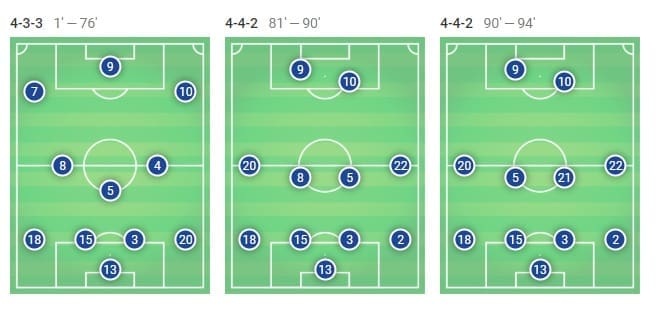
Sevilla’s setup
Machin had a steady lead before entering Barcelona’s fortress but also a dangerous one. It seems that the Catalans are at their best when chasing an unfavourable result, as has been the case more than once. Sevilla had a two-goal advantage but against as high a scoring team as Barcelona, it was not something to rely on heavily.
A couple of changes saw the Andalusians alter their approach only slightly from the first leg. Soriano was still the man between the sticks but Carrico and Mercado swapped places, the latter was on the bench this time.
Higher up the pitch, once again we saw the core mostly untouched with Banega, Amadou, Sarabia and Promes all selected but Ben Yedder was benched. Mesa, Silva and Arana were some of the new names starting at the Camp Nou.
Machin decided on three at the back again, and put a lot of emphasis into the midfield. He formed a sort of 3-5-2 formation which would sometimes resemble a 3-5-1-1, with Andre Silva often highest up the pitch.
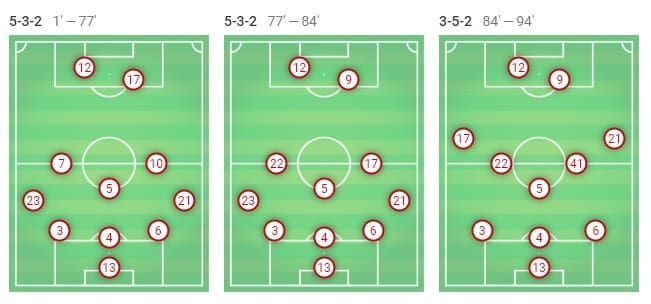
The Messi effect
One glaring and, in fact, the biggest difference from the first to the second leg was just one name on the team sheet: Lionel Messi. How many times have we already heard that statement? Probably too many, but game after game it always holds true.
The little Argentine magician was once again one of the standout performers, although his name was missing from the score sheet until the very last moments of the game. His sheer presence had a psychological impact which was clearly visible on the field. We are more interested to see how it translated into the preparation of the match in the first place.
Placing only three men at the back at all times would have been far riskier when defending so Machin decided to deploy a rather low and narrow block with five defenders as his team soaked up the pressure. Still, Sevilla would swap between the three-man and five-man defence depending on the stage of Barcelona’s advancement up the field.
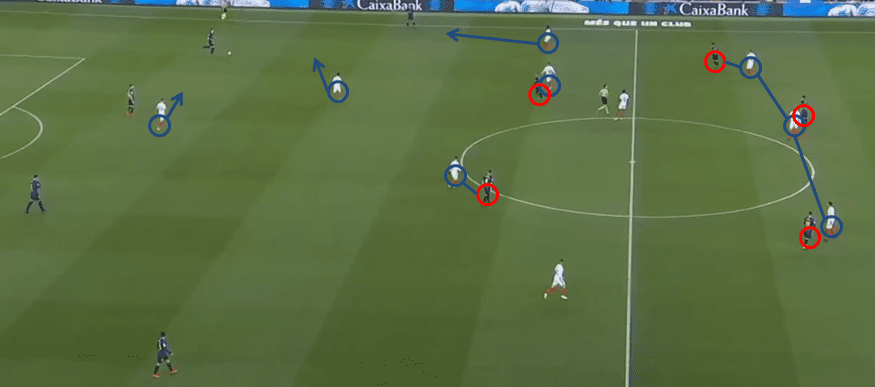
Notice how Barcelona try and build from the back and Sevilla’s press is triggered. Both strikers move higher up the pitch, and four men in midfield try to shut down any connection between the Catalans’ first and second thirds. In that scenario, only three defenders were necessary to hold the front trio of Messi, Suarez and Coutinho.
If and when the press was broken, and Barcelona navigated through it, Sevilla quickly swapped to a five-man defence and pulled the whole squad behind the ball in their own half. In that case, only three midfielders remained as the dominance in the middle was sacrificed to ensure the overlapping full-backs were blocked.
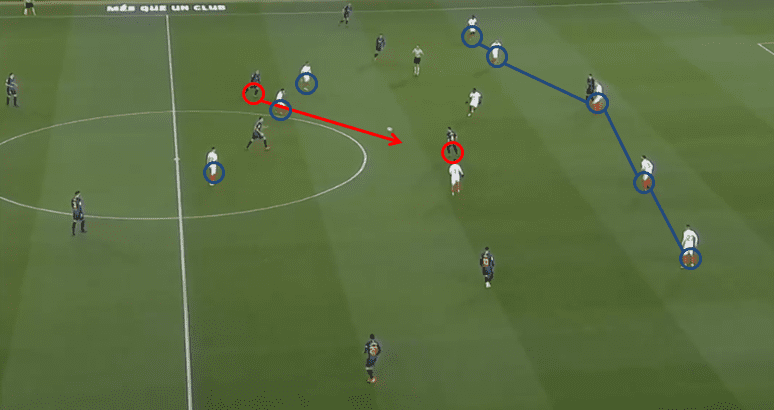
Their defending was mostly zonal but there was always one clear aspect: tight man-marking. There was not a single occasion when one of the front three was left alone, and Machin definitely prioritised outnumbering Barca’s midfield, hence the numerical advantage the Andalusians created whenever possible.
This had two clear effects. The progress of the ball through the middle was made much more difficult due to it being highly congested with white shirts at all times. It also allowed multiple players to crowd the player in possession as quickly as possible.
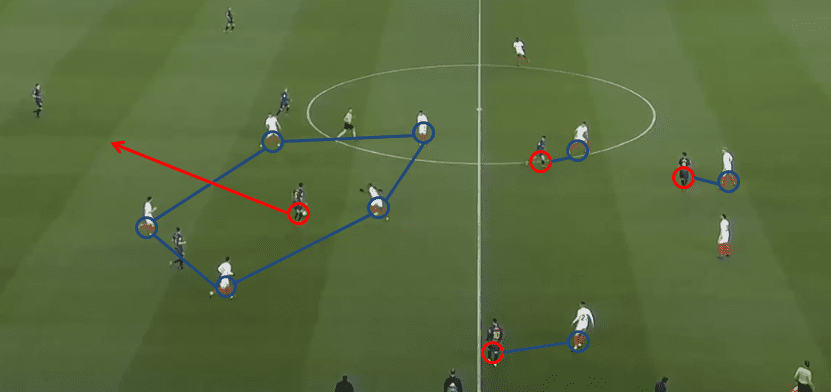
In the image above, quick crowding by the defending team ensures the ball is sent backward instead of forward. Also, note how each of the forwards is practically marked out of the attack and is unlikely to receive the ball in this scenario.
Back to the topic at hand – Lionel Messi – although excessive man-marking was applied to all three of Barcelona’s forwards, Messi received special treatment again.
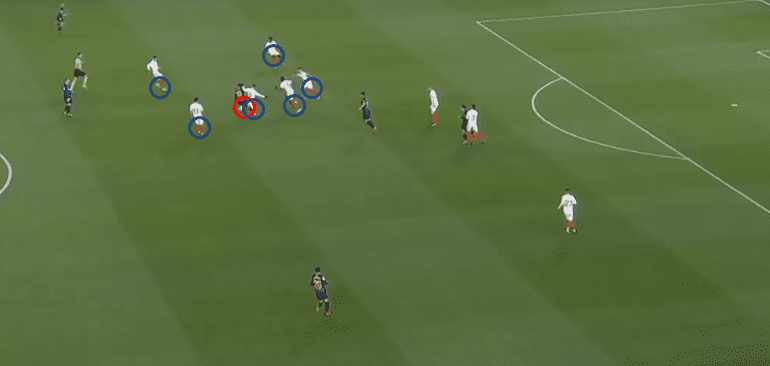
This is just one of the numerous examples throughout the game that proves Machin had to prepare a whole tactic just for Messi. Ernesto Valverde knew this would happen so he thought of a counter, but all the heavy lifting was done by the Argentine.
It’s difficult to mark Messi out of the game. No matter how many players you put on his back, he will either beat them all, set up play instead of finishing it or simply use up most of your resources and lift the burden off of his teammates. However, he is not the only one who did it to great success.
Let’s break down the attack that resulted in Barcelona’s second goal.
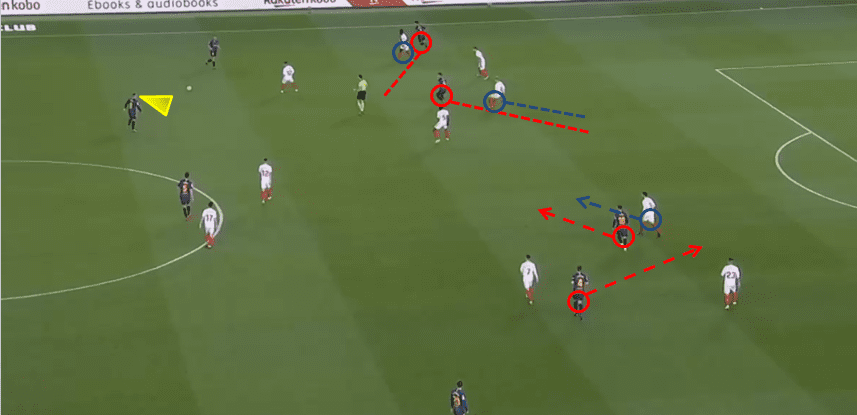
There are a number of key things to note in this attack. Coutinho, Suarez and Messi all drag their markers to free some space behind them, while Arthur is already scanning and planning his next move. Rakitić sees an opening and takes it.
The emphasis is once again on the forwards, even though none of the three deal the finishing blow. Firstly, notice how Coutinho moves from his left half-space and goes wide, just in front of Alba. This attracts the first defender and creates space, and with Jordi being there as the focal point he usually is, Sevilla decide to overcrowd that whole flank. This blocks any chances of an overlap but in doing so, risks a shortage of personnel in other areas.
Secondly, Luis Suarez drags his marker towards the midfield, and out of position, and Messi does the same with his. This frees enough space for Ivan Rakitić, of all people, to exploit. This is also something that Valverde decided to implement as Rakitić was not there coincidently.
A midfield trident of Busquets, Arthur and Rakitić is probably the first choice of Valverde, but it lacks the aggression and presence Arturo Vidal usually offers. Rakitić was the one who was given a more attacking role this time, as the remaining two would mostly stay back as double pivots.
Usually when Vidal starts, the Chilean and Messi tend to swap places to let the Argentine drop deeper to create from midfield, leaving Vidal to act as a false nine of sorts. This time, again, Rakitić took it upon himself to do exactly the same.
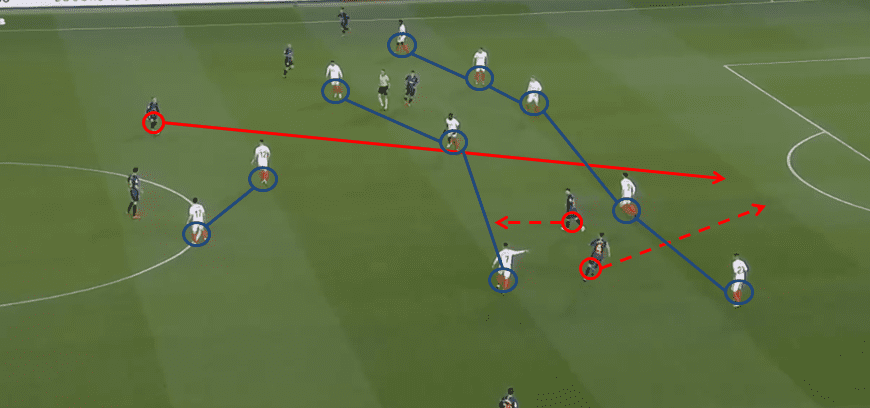
Of course, how could one forget about Arthur Melo? Just seconds after first scanning the field for possible chances, the young ‘Brazilian Xavi’ sends a pinpoint through-ball, breaking all of Sevilla’s three lines, and beating a total of eight players with a single pass: absolutely magical.
Rakitić receives the ball and applies nothing more than the faintest of touches to send it past Soriano to make it 2-0. The chance was created seemingly out of nothing, and Sevilla failed at the very core of their system. Their defending was supposed to make sure no balls penetrated through the middle, but great movement from the rest of Barcelona’s team made some necessary space for the pass to be possible in the first place.
Arthur was still much more than just that one pass. The Brazilian dominated the midfield like the true maestro he is dubbed to be. Out of 66 passes, 90% were accurate, and apart from that one assist, Melo also managed to win six out of eight duels and send two key passes, not to mention completing 100% of long balls and dribbles, both two out of two. Defensively, he was also on point with one interception and two tackles to his name.
It was a performance to remember for the young midfielder. The parallels with Xavi Hernandez were never more visible as Arthur continues to grow with each game under his belt. All of that in his first season in Europe.
Outstanding.
Breaking point
Judging from the final scoreline and the rest of the analysis, it would be easy to assume Barcelona had complete control throughout the game. This was, however, not really the case. Sure, they ended up putting six goals past their opponents, but when the game was up for grabs, Sevilla had a chance to kill the flames before they spread.
We’re talking about Ever Banega’s missed penalty which would have brought them back on level terms. Jasper Cillessen gave Banega his first penalty miss in all competitions for the Andalusians. It was also the Dutchman’s first penalty save in an official game in 26 attempts, and he couldn’t have picked a better game in which to do it.
That was Sevilla first big chance to upset the (still) favorites but they missed it, and it flew past them faster than they could ever imagine. Still, as the match went past its breaking point, the pressure was still on one player in particular: Philippe Coutinho.
The Brazilian, Barcelona’s biggest purchase in the club’s rich history, had been heavily under fire from critics and fans alike for his poor performances. This game, he had to step it up. After he regained some confidence with the penalty Messi so generously gifted him, he was back to his magical self.
Facing a team so adamant on tight man-marking, Barcelona’s forwards had to use their imagination and skill to the fullest in order to escape the defenders. Coutinho was pretty good at that with some slick movement, and with constant swapping of positions.
As we have already seen above with Rakitić’s goal, Coutinho would often drift wide to attract attention and take defenders away from their usual positions. In those scenarios, he would either go from the left half-space to the left wing or vice versa.
One other thing he would do is attack the free space more consistently than before. Instead of waiting for the ball to come to him, he would make himself available by moving into the zones with no defenders via darting runs behind the back line, as was the case before the first goal, for his second one, and numerous times afterwards.
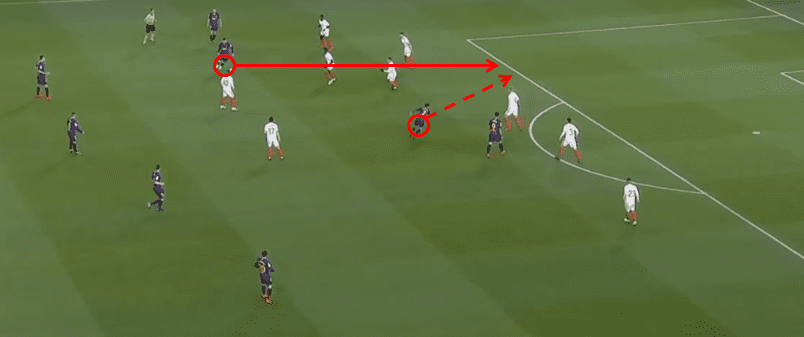
Rakitić was also a figure of interest in the midfield. As we already mentioned before, he would be the midfielder highest up the pitch at most times. His Vidal-esque runs were almost always triggered by swapping places with one of the forwards. Just as he did with Messi for his own goal, he did so with Coutinho as well, as can be seen below.
This was Barcelona’s way of beating the tight five-man defensive line. By constantly swapping places they brought disorder and chaos into the mix, pulling multiple people out of position at all times.
Just before the image below, Suarez and Coutinho switched places as the Uruguayan went wide to the left, dragging one defender, with the Brazilian dragging the other deeper seconds later. Rakitić sees it happen and quickly swaps places with the Brazilian, which rids him of any markers and enables him to attack the free space right after.
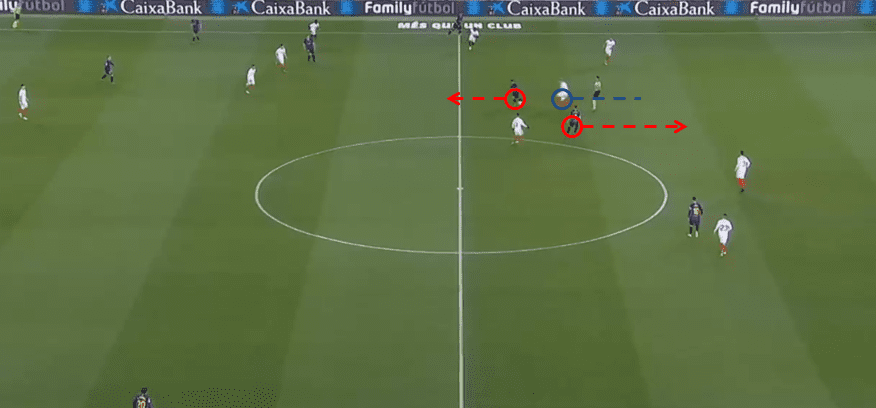
The silver lining
Although it may certainly seem that way, it was not all dark and gloomy for the guests. Sevilla did cause some damage to the Catalans. Even though it did not bring them the result they wanted, their pressure was most notably felt in the final stages of the game.
One player that really stood out was Promes on the right wing. His excellence was actually a double victory on the field for Sevilla; his constant pressure meant that Alba was not as active as he maybe would’ve wanted to be, and it also meant that they always had an attacking outlet up their sleeves.
By being able to beat the speedy Spaniard in a one-on-one battle, Promes made sure that Alba didn’t go too far up the pitch since it would be too big of a risk to take. Still, when they attacked, it was mostly either a quick transition-based counter or an attack down the wings.
Barcelona had two approaches to defending: high pressure, or a transition to a more compact 4-4-2 with Messi and Suarez (mostly) not participating. Still, those transitions were the only real moments when Sevilla had the power to cause more serious damage to the hosts.
By overloading of the midfield, the chance of an interception (or a mistake by Barca) was suddenly higher. This did work to a certain extent as 46% of all losses did happen in Barcelona’s midfield as Sevilla mustered a total of 45 interceptions.
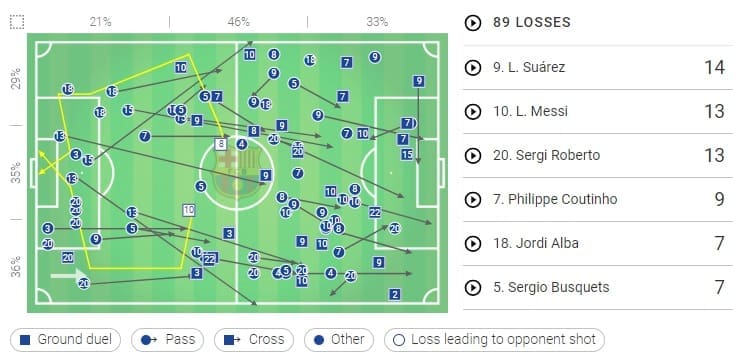
Conclusion
It was quite a night at the Camp Nou as another 6-1 remuntada was seen in Catalunya. Of course, this one was far smaller than the infamous one against PSG, but a pretty dominant display nonetheless. It was a shame only 58,050 people got to see it live as a midweek Copa game did not spark that much interest. Perhaps it was expected that Barca would forfeit the domestic cup in favour of the more coveted Champions League.
Whatever the case may be, the Blaugrana machine marches onward and is still very much firing on all cylinders. Now, a much bigger challenge awaits in the semi-finals in the form of their eternal rivals, Real Madrid.
For now, the Ant and his troops turn their attention back to La Liga. Soon it will be time for another Clasico, however, and those never fail to amaze.
If you love tactical analysis, then you’ll love the digital magazines from totalfootballanalysis.com – a guaranteed 100+ pages of pure tactical analysis covering topics from the Premier League, Serie A, La Liga, Bundesliga and many, many more. Buy your copy of the January issue for just ₤4.99 here, or even better sign up for a ₤50 annual membership (12 monthly issues plus the annual review) right here.

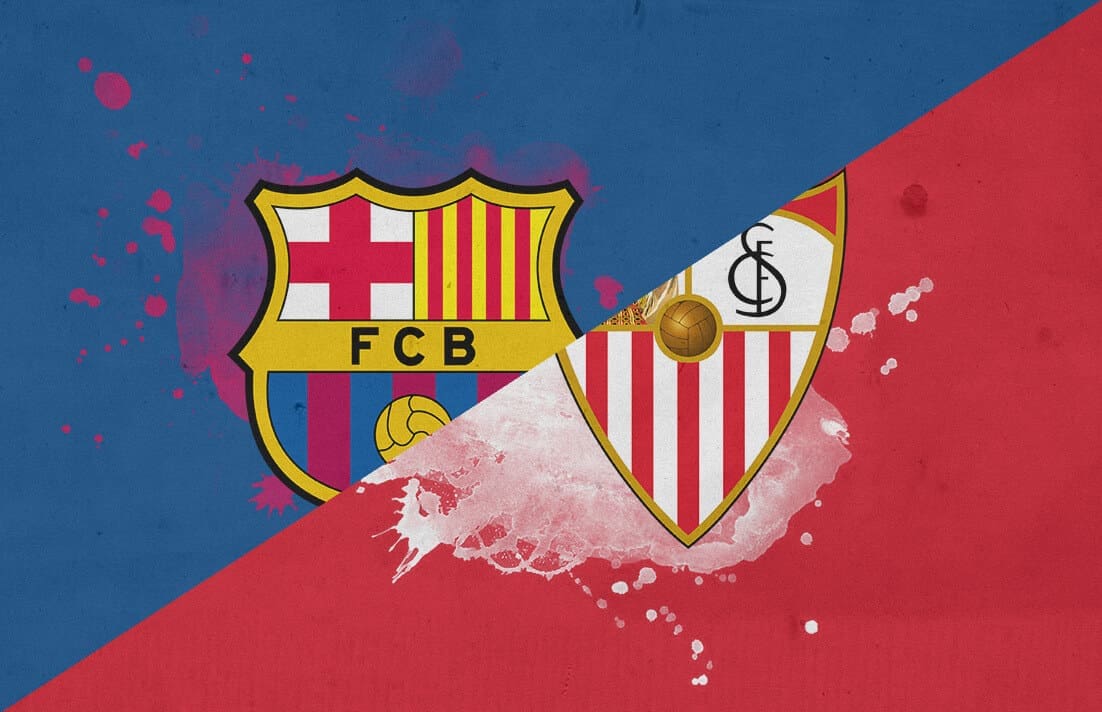




Comments